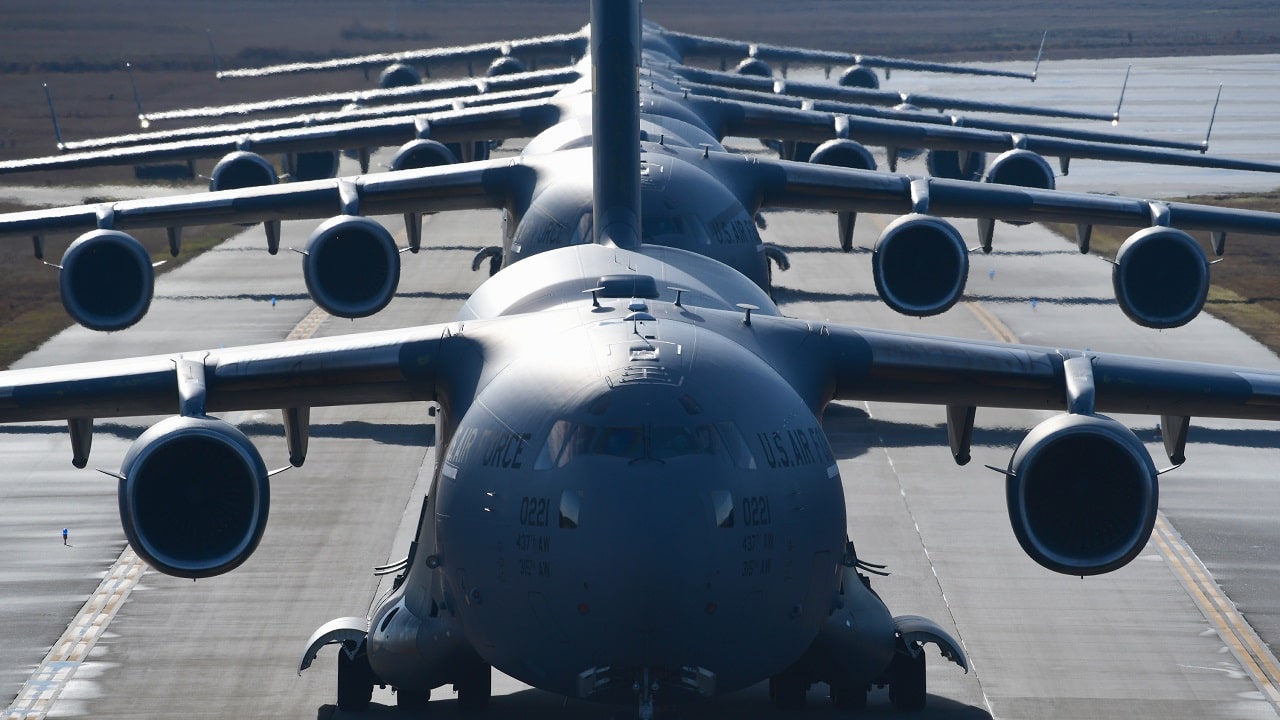It is typically bombers that take part in the U.S. Air Force’s elephant walks and mass deployments as a show of force. But this past weekend it was the turn of the C-17 Globemaster III – the most flexible cargo aircraft to enter the airlift force. The C-17 is capable of rapid strategic delivery of troops and cargo to main operating bases or to forward bases in the deployment area. The aircraft ensures the U.S. can respond to a crisis anytime, anywhere.
(Subscribe to Our YouTube Channel Here. 19FortyFive publishes new videos every day.)
That ability was put on display this weekend at Joint Base Charleston, where 24 Globemaster IIIs took part in a mission generation exercise that integrated U.S. Air Force, Army, and Marine forces across five operating locations.
The exercise marked the largest C-17 launch ever from a single base and demonstrated the wing’s ability to rapidly generate and project overwhelming airpower alongside joint partners, Joint Base Charleston announced.
“Air Mobility Command is the meaningful maneuver for the joint force, and our asymmetric advantage is our adaptable, talented Airmen,” said Maj. Gen. Corey Martin, 18th Air Force commander. “Every day we are learning new lessons that we want to apply in combat, so this mission generation exercise is a chance to test our capabilities at a tempo and scale that approximates combat operations.”
Show Of Force
The exercise included a show-of-force flight over the Ravenel Bridge in Charleston Harbor. The C-17s then dispersed to sharpen four core capabilities, which included command-and-control, navigation, tempo, and logistics under fire. More than 20 red- and blue-air F-16 Fighting Falcons from Shaw Air Force Base and McEntire Air National Guard Base, both in South Carolina, took part in the exercise. They engaged in a simulation fight for air superiority while joint forces leveraged rapid mobility to establish a simulated missile defense system.
“We have to fight to get to the fight,” explained Col. Robert Lankford, 437th Airlift Wing commander. “This exercise tests our ability to accomplish the mission, while geographically dispersed and with limited communications.”
Multiple Deployments
The twenty-four C-17s headed to multiple locations during the joint force exercise. The first group landed at Pope Army Airfield (AAF), North Carolina, where airmen worked alongside a Joint Communications Support Element to establish a tactical operations center. This is meant to provide secure communications and decentralized command structures that enhance critical decision superiority and prevent disruption.
Additional C-17s landed at Pope AAF to retrieve special tactics airmen, then took off and flew to the nearby Holland drop zone, where the airmen accomplished a static line jump. Once on the ground, they secured the dirt landing strip for follow-on operations.
At Marine Corps Air Station Cherry Point, North Carolina, C-17 aircrews landed, quickly uploaded HIMARS rocket launchers, then flew to Pope AAF andperformed a HIMARS rapid infiltration. The C-17s that landed at Marine Corps Air Station Beaufort, South Carolina, executed an integrated combat turn to quickly refuel a number of U.S. Army AH-64 Apache helicopters.
Finally, at Hunter Army Airfield, Georgia, aircrews focused on logistics under fire. They had to leverage multi-capable concepts to maneuver cargo. They exercised skills that are outside of their primary duties in order to accomplish the mission.
“What we’re practicing are flexible deterrent and flexible response options,” said Maj. Zachary Barry, C-17 pilot and lead planner for the exercise. “If we can move really quickly, it makes it harder for the adversary to respond.”
During the weekend’s exercise, nearly 60 aircraft took to the skies, including an E-3 Sentry and KC 135 Stratotankers. They synchronized capabilities to maximize lethality, and airmen also experimented with C2 equipment that will provide information for aircrews, increasing their battlespace awareness in a contested environment.
MORE: Is Donald Trump a ‘Cognitive Mess’?
MORE: Should Joe Biden Really Run in 2024?
MORE: Ron DeSantis May Peak Too Early
Author Experience and Expertise: A Senior Editor for 19FortyFive, Peter Suciu is a Michigan-based writer. He has contributed to more than four dozen magazines, newspapers, and websites with over 3,200 published pieces over a twenty-year career in journalism. He regularly writes about military hardware, firearms history, cybersecurity, politics, and international affairs. Peter is also a Contributing Writer for Forbes and Clearance Jobs. You can follow him on Twitter: @PeterSuciu.

